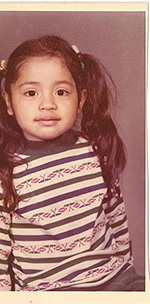My Encounter with Helena Horowitz
I first learned about Helena Horowitz’s life history when I found her testimony as I searched through the archive in IWitness the Institute’s educational website featuring the testimonies of survivors and other witnesses to the Holocaust and other genocides.
It was April 2013 and there I was, searching and listening to testimony when Helena Horowitz, born in 1926 Poland, a survivor of the Holocaust, began telling the stories of how she managed through her days as a Jew during Nazi-occupied Poland. She went on to describe the self-preservation strategies she used to prevent from being exposed.
And that is where it hit me. It was visceral. It was instantaneous.
Helena Horowitz described in very clear and rich details the ways I also sustained my own false identity growing up as an undocumented student in 1970’s Los Angeles. Helena Horowitz was telling my story, too.
She says, “[I always carried] the fear of being recognized. Always alert. Always listening to people, who is coming, who is going, who is something, knowing what to say. There were instances when I thought, “That’s it!”
I could have written those words myself. But it was Helena Horowitz, a model of courage that resonated with me as she described obtaining false papers to pass as a non-Jew and using the avoidance strategies she employed on a daily basis. That was me. I, too, had false papers, I avoided large crowds and I remember my mother invariably reminding me every chance she had, “No digas nada” (don’t say anything). I knew what it meant and I kept quiet.
Those were my strategies. And those were the strategies I had not shared throughout my childhood and most of my adult life. It’s a complicated experience, not easily and neatly available for sharing. But there was Helena Horowitz to ease those memories back and that was a good thing.
And ever since my encounter with Helena Horowitz that spring of 2013, I have come to appreciate more fully the power of testimony like Helena Horowitz’s, and over 50,000 testimonies in the USC Shoah Foundation’s Visual History Archive, which have the capacity to bridge time and space and across differences, giving voice to our stories in a safe place and through a compelling digital medium. And that is the power of the Institute’s Visual History Archive. I invite you to see how even your own story also lies in the testimony of another Helena Horowitz.
 Claudia Wiedeman, circa 1974 in Los Angeles.
Claudia Wiedeman, circa 1974 in Los Angeles.Like this article? Get our e-newsletter.
Be the first to learn about new articles and personal stories like the one you've just read.